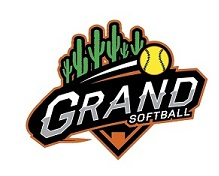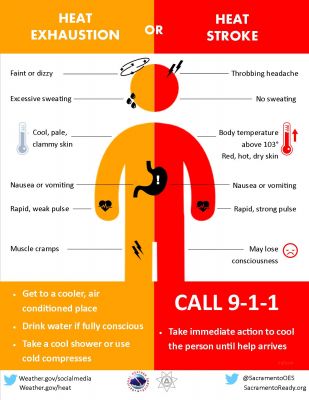Heat Exhaustion/Heat Stroke
HYDRATE HYDRATE HYDRATE HYDRATE
see file below from CDC "How much water should I drink"
Heat exhaustion is one of the heat-related syndromes. Symptoms range in severity from mild heat cramps to heat exhaustion to potentially life-threatening heatstroke. Heat exhaustion can begin suddenly, usually after working or playing in the heat, perspiring heavily or being dehydrated. In the winter-time in Arizona you may not ‘feel’ overheated but given our dry climate, physicians warn that this time of year is the worst for heat exhaustion. Heat exhaustion signs and symptoms include:
- Faintness or dizziness
- Nausea or vomiting
- Heavy sweating often accompanied by cold, clammy skin
- Weak, rapid pulse
- Pale or flushed face
- Muscle cramps
- Headache
- Weakness or fatigue
If you suspect heat exhaustion
Untreated, heat exhaustion can lead to heatstroke, which is a life-threatening condition. If you suspect heat exhaustion, take these steps immediately:
- Move the person out of the heat and into a shady or air-conditioned place.
- Lay the person down and elevate the legs and feet slightly.
- Remove tight or heavy clothing.
- Have the person drink cool water or other nonalcoholic beverage without caffeine.
- Cool the person by spraying or sponging with cool water and fanning.
- Monitor the person carefully.
Call 911 or your local emergency number if the person's condition deteriorates, especially if he or she experiences:
- Fainting
- Confusion
- Seizures
- Fever of 104 F (40 C) or greater
PRACTICAL TIPS FOR EXERCISE HYDRATION
#1: DRINK TO THIRST
Thirst is a tightly regulated system. You do not usually need to go beyond it. And when you do drink, remember to:
#2: DRINK ELECTROLYTE WATER
You lose both sodium and water through sweat. If you only replace the water, your sodium levels will fall. Then you will feel and perform like garbage.
- Two options here:
- Mix up your own electrolyte home-brew.
- Use a high-sodium electrolyte drink mix like Liquid IV (Costco), Ultima (Amazon, Walmart)
- Gatorade, Propel, Pedialyte, or anything with electrolytes in it.
- Remember, athletes can lose up to 7 grams of sodium per day while exercising in warm climates. You may need more than one stick on the sweatiest of days! Start hydrating the night before and limit the amount of coffee prior to exercise since coffee is a diuretic. (Coffee, tea, soda, and alcohol are drinks that people associate with dehydration)
#3: HYDRATE BEFORE, DURING, AND AFTER EXERCISE
Don’t wait until the race is over to worry about hydration. Sip electrolyte water before and during exercise too.
#4: WHICH LIQUIDS ARE THE BEST
For most outdoor activities, good old-fashioned tap water does the trick. If your activity lasts an hour or more, either fruit juice diluted with water or a sports drink will provide carbohydrates for energy plus minerals to replace lost electrolytes (sodium, potassium, magnesium) in your sweat. Learn what electrolytes do, as well as which foods have the highest content.
Sports drinks like Gatorade, Powerade, and All Sport can give you a needed energy boost during your activity. They are designed to rapidly replace fluids and to increase the sugar (glucose) circulating in your blood.
How does dehydration affect athletic performance?
Our body is 50-65% water and proper hydration plays a role in everything from overall athletic performance and mental focus to immune health. Dehydration can negatively impact performance and cause early fatigue. Symptoms of dehydration include headache, dark urine, dizziness, fatigue, irritability, poor appetite, nausea, and cramping.
WEBMD Article: Kathleen M. Zelman, MPH, RD, LD
Article written by: Robb Wolf

